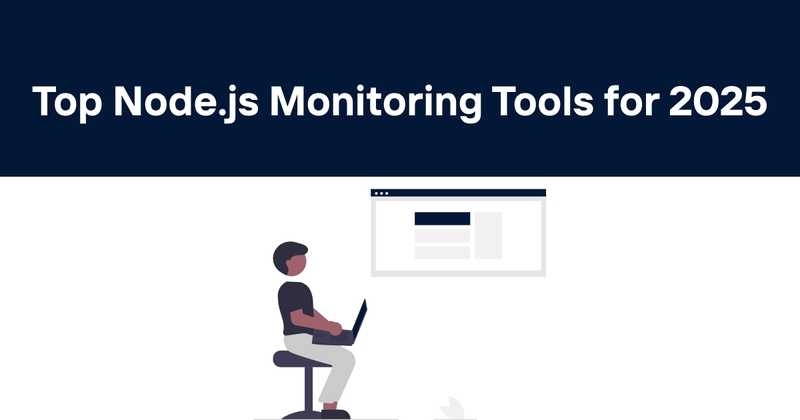Top Node.js Monitoring Tools for 2025
Node.js has become a cornerstone of modern web development, powering everything from small startups to enterprise-grade applications. But with great power comes great responsibility - and the need for robust monitoring. Let's dive into some of the best open-source tools to keep your Node.js apps running smoothly.
Table of Contents
- Why Monitor Node.js Applications?
- Key Metrics to Watch
- Top Open-Source Monitoring Tools
- Setting Up Prometheus with Docker
- Best Practices for Node.js Monitoring
- Comparing Open-Source vs. Commercial Solutions
- The Future of Node.js Monitoring
- Conclusion
Why Monitor Node.js Applications?
I've been working with Node.js for years now, and if there's one thing I've learned, it's this: what you don't measure, you can't improve. Monitoring isn't just about putting out fires (though it's great for that too). It's about understanding your application's behavior, optimizing performance, and catching issues before they become full-blown problems.
Think of it like this - would you drive a car without a dashboard? No way! You need to know how fast you're going, if you're running out of gas, or if the engine's about to overheat. Monitoring is your application's dashboard.
Key Metrics to Watch
Before we jump into the tools, let's talk about what we should be monitoring. In my experience, these are the key metrics you'll want to keep an eye on:
- CPU Usage
- Memory Consumption
- Event Loop Lag
- HTTP Request Rate
- Response Times
- Error Rates
- Garbage Collection Frequency and Duration
Each of these metrics tells a story about your application's health and performance. High CPU usage might indicate inefficient code. Memory leaks will show up as steadily increasing memory consumption. A lagging event loop can cause your app to become unresponsive.
Top Open-Source Monitoring Tools
Now, let's get to the good stuff - the tools that'll help you keep tabs on all these metrics. I've spent countless hours tinkering with various monitoring solutions, and these are the ones that have consistently impressed me.
Appmetrics
Appmetrics is like that friend who always knows what's going on - it gives you a comprehensive view of your Node.js application's performance.
To get started, just install it with npm:
Then add this line to the top of your main file:
Boom! You now have a web-based dashboard at /appmetrics-dash. It's packed with useful info:
- CPU Profiling
- HTTP Request Metrics
- Event Loop Times
- Garbage Collection Stats
What I love about Appmetrics is how easy it is to set up. It's perfect for quickly getting insights into an application without a lot of configuration hassle.
Express Status Monitor
If you're using Express.js (and let's face it, who isn't?), Express Status Monitor is a no-brainer. It's dead simple to set up and gives you real-time metrics right in your browser.
Here's how to add it to your Express app:
const app = express();
app.use(require('express-status-monitor')());
Navigate to /status and you'll see a slick dashboard with charts for:
- Response Time
- Requests per Second
- CPU Usage
- Memory Usage
I often use Express Status Monitor for quick checks during development. It's lightweight and doesn't add much overhead to your application.
Prometheus
Ah, Prometheus. It's like the Swiss Army knife of monitoring tools. It's not just for Node.js - you can use it to monitor pretty much anything. But it works great with Node, and it's what I reach for when I need serious, production-grade monitoring.
Setting up Prometheus requires a bit more work, but it's worth it. You'll need to:
- Install the Prometheus client for Node.js
- Set up a Prometheus server
- Configure your app to expose metrics
Here's a quick example of how to expose metrics in your Node.js app:
const collectDefaultMetrics = client.collectDefaultMetrics;
collectDefaultMetrics({ timeout: 5000 });
app.get('/metrics', (req, res) => {
res.set('Content-Type', client.register.contentType);
res.end(client.register.metrics());
});
What I love about Prometheus is its flexibility. You can create custom metrics, set up alerting rules, and integrate it with visualization tools like Grafana for some seriously beautiful dashboards.
Clinic.js
Clinic.js is like having a team of performance experts on call. It's actually a suite of tools designed to diagnose performance issues in Node.js applications.
It includes three main tools:
- Doctor: Gives you an overall health check of your application
- Bubbleprof: Profiles async operations (super useful for Node.js!)
- Flame: Creates flame graphs to visualize CPU usage
To use Clinic.js, you typically run it alongside your application:
Then you generate some load, stop your app, and Clinic.js will generate a report.
I find Clinic.js invaluable for deep-diving into performance issues. When I'm stumped by a particularly nasty performance problem, Clinic.js often helps me uncover the root cause.
PM2
PM2 is a bit different from the other tools we've looked at. It's primarily a process manager for Node.js applications, but it also includes some great monitoring features.
To start your app with PM2:
Then you can use pm2 monit to see a live dashboard of your application's performance.
What sets PM2 apart is its ability to manage multiple Node.js processes. It can automatically restart your app if it crashes, and it can help you take advantage of all your server's CPU cores.
I often use PM2 in production environments. Its combination of process management and monitoring features makes it a powerful tool for keeping Node.js applications running smoothly.
Setting Up Prometheus with Docker
I mentioned earlier that setting up Prometheus requires a bit more work. But here's a little trick I've learned that makes it much easier: use Docker!
Here's a quick guide to get you started:
- Create a
prometheus.ymlfile:
scrape_interval: 15s
scrape_configs:
- job_name: 'nodejs'
static_configs:
- targets: ['host.docker.internal:3000']
- Run Prometheus in a Docker container:
-v $(pwd)/prometheus.yml:/etc/prometheus/prometheus.yml\
prom/prometheus
- Make sure your Node.js app is exposing metrics on port 3000.
And that's it! You can now access the Prometheus UI at http://localhost:9090.
Using Docker like this makes it easy to experiment with Prometheus without messing up your system configuration. Plus, it's a breeze to deploy to production environments that support Docker.
Best Practices for Node.js Monitoring
After years of working with Node.js, I've developed a few best practices for monitoring:
-
Monitor in all environments: Don't wait for production to start monitoring. Set up monitoring in your development and staging environments too.
-
Use multiple tools: Each tool has its strengths. I often use a combination of tools to get a complete picture of my application's performance.
-
Set up alerts: Monitoring is useless if you're not notified when something goes wrong. Set up alerts for critical metrics.
-
Don't over-monitor: It's tempting to track everything, but this can lead to information overload. Focus on the metrics that matter most for your application.
-
Regularly review and update: Your monitoring needs will change as your application evolves. Regularly review your monitoring setup and update it as needed.
-
Document your monitoring setup: Make sure your team knows what's being monitored and how to interpret the results.
Comparing Open-Source vs. Commercial Solutions
While we've focused on open-source tools in this article, it's worth mentioning that there are also many excellent commercial monitoring solutions available. Tools like New Relic, Datadog, and Sematext offer powerful features and integrations.
So, which should you choose? Here's my take:
Open-source tools are great if:
- You're on a tight budget
- You need full control over your monitoring setup
- You have the technical expertise to set up and maintain the tools
Commercial solutions might be better if:
- You want a more polished, out-of-the-box experience
- You need advanced features like AI-powered anomaly detection
- You want dedicated support
In my experience, many teams start with open-source tools and move to commercial solutions as their needs (and budgets) grow. There's no one-size-fits-all answer - it depends on your specific situation.
The Future of Node.js Monitoring
As we look ahead to the future of Node.js monitoring, a few trends stand out:
-
AI and Machine Learning: We're starting to see monitoring tools that use AI to detect anomalies and predict potential issues before they occur. I expect this trend to accelerate.
-
Increased Focus on Security: With the rise of security threats, monitoring tools are likely to incorporate more security-focused features.
-
Better Integration with Cloud Services: As more applications move to the cloud, monitoring tools will need to provide deeper integration with cloud services.
-
Improved Visualization: We'll likely see more advanced and interactive visualizations that make it easier to understand complex performance data.
-
Edge Computing Support: As edge computing becomes more prevalent, monitoring tools will need to adapt to support distributed architectures.
It's an exciting time to be working with Node.js, and I can't wait to see how these monitoring tools evolve to meet the challenges of the future.
Conclusion
Monitoring is a crucial part of maintaining healthy Node.js applications. The tools we've looked at - Appmetrics, Express Status Monitor, Prometheus, Clinic.js, and PM2 - each offer unique features to help you keep your apps running smoothly.
Remember, the best monitoring setup is the one that fits your specific needs. Don't be afraid to experiment with different tools and combinations until you find what works best for you.
And speaking of tools that work, I'd be remiss if I didn't mention Odown. While it's not specifically a Node.js monitoring tool, Odown is fantastic for monitoring overall website and API uptime. Its public status pages and SSL certificate monitoring features are particularly useful for maintaining transparency with your users and ensuring your site's security.
So, whether you're using open-source tools, commercial solutions, or a combination of both, the important thing is that you're monitoring your Node.js applications. Your future self (and your users) will thank you!



